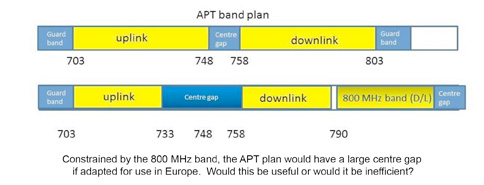The 700 MHz Band: battleground or ‘fait accompli’?
The most important reason for the ECC to look at 700 MHz now (694 – 790 MHz) is the rising demand for mobile broadband services. This is not the only claim on the frequencies; notably there is the widespread existing use for terrestrial TV, using the GE06 digital TV plan which is a commitment by all countries in Europe, the Middle East and Africa. There are other services too, including the aeronautical radio navigation system in parts of eastern Europe (beyond the EU). There are some major differences in the national situations - current and envisaged - across Europe, especially with respect to broadcasting. So an identical pan-European approach based around just one service per frequency range may well be too simple and too inflexible. However, the large technical incompatibility between terrestrial broadcasting and mobile services across national borders, especially uplink mobile traffic, makes it essential to have a management framework and coordination of approach in place at the European level.
Europe's problems are possibly greater than in many other parts of the world due to the relatively small size of the countries and their high population density in many places, including near border areas. However, this challenge is not uniquely European. This is reflected in the treatment of the issue at the World Radiocommunication Conferences (WRC), which regularly modify the framework of international radio regulations. The WRC of 2012 decided that, as of the end of WRC 2015, mobile services would enjoy co-primary status with broadcasting over the frequency range 694 MHz to 790 MHz. At the very least this impacts on how the GE06 plan is used. WRC-15 will refine the technical details of this decision, including exactly where the lower band edge should be placed. It will also consider other frequency ranges for mobile, largely driven by the worldwide demand for mobile broadband services.
These WRC decisions in particular have shaped the dynamics of the ECC's work. The ECC Conference Preparatory Group’s Project Team D (CPG - PTD) is tasked with preparing CEPT’s positions on the relevant topics1. PTD’s meetings are coordinated with those of our public mobile-specialising Project Team, PT1, and both are chaired by Didier Chauveau of France.
This work is closely aligned to the equivalent interest of the European Commission. Specifically, the ECC is now working on a response to a mandate from the European Commission to define appropriate technical conditions for wireless (=mobile) broadband over this range. The Commission stresses that this is without prejudice to "the final decision on use of the band, which should be decided by an EU level political agreement", but this work should give a technical basis to inform such an agreement, and the Commission’s timescales are in step with CEPT’s preparations for WRC-15. The ECC started work on the mandate in March of this year. PT1 is leading it, but other groups, especially PTD, also contribute. After an initial report this October, a draft will go to public consultation in June 2014, with the final mandate response in October 2014. CEPT will be able to draw on this work in preparing for the WRC-15 Conference Preparatory Meeting (CPM) which takes place from 23 March to 2 April 2015.
The mandate work will mainly focus on the core technical arrangements. This includes the channelling and block-edge mask, and compatibility with broadcasting (as well as between the same mobile service) across national boundaries. This is unlikely to reveal major differences of principle compared with equivalent work already done for the first digital dividend in the 800 MHz band (792 - 862 MHz). This mandate directs that other issues be considered also, especially the accommodation of services like Programme Making and Special Events (PMSE), as well as non-radio services such as (particularly) cable television receiver boxes. The latter is not relevant to us in the ECC as a radiocommunications issue but it is a difficult fact of life as an issue of electromagnetic compatibility. To the public the division of responsibilities between regulators and regulations is not of interest – only whether devices work properly, and can be purchased with confidence.
There is significant pressure to adopt the same plan as that already agreed by the Asia-Pacific Telecommunity (APT). This would allow manufacturers to save costs by realising economies of scale into a larger market with a (relatively small) part of the handset design. On the other hand this is only one of a large number of factors which affects the economics of this band of spectrum. The need to be compatible with the now-committed 800 MHz European band structure means that the APT-based band plan may not be the most efficient to use in Europe. So the ECC has a lot of factors to consider in its work.

¹Agenda Item 1.2 to review studies on use of 700 MHz for mobile; Agenda item 1.1 considers what other frequencies should be allocated to mobile. PTD will contribute to and therefore seek to influence these studies, which are being carried out in ITU-R’s Joint Task Group JTG 4-5-6-7.
